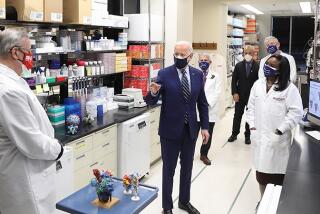AIDS Groups Urge Firm to Lower AZT Price
SAN FRANCISCO — Charging that the stratospheric cost of the drug AZT “must be measured not only in dollars but in lives,” a broad coalition of AIDS organizations Wednesday called on manufacturer Burroughs Wellcome Co. to substantially lower the drug’s price.
The organizations said the urgency of their call was underscored by two factors: the expiration of an emergency federal subsidy program for AZT at the end of September and the release of data earlier this month confirming the efficacy of AZT in delaying progression of the human immunodeficiency virus in hundreds of thousands of people with no symptoms or early symptoms of AIDS.
AZT, whose trade name is Retrovir, costs $8,000 to $10,000 per year for dosage recommended for full-blown AIDS, making it one of the most expensive prescription drugs ever produced. Even the lower dosage that was shown to be effective in cases of early HIV infection costs $3,500 to $4,000 a year.
The call for lower prices was initiated by San Francisco-based Project Inform co-founder Martin Delaney and was joined by 16 groups, ranging from the mainstream American Foundation for AIDS Research to the militant AIDS Coalition to Unleash Power.
The new evidence that AZT can delay the development of full-blown AIDS “offers dramatic promise of buying precious time for the majority of those infected with HIV,” the joint statement said. But the promise would be hollow if the drug’s high cost “limits it use among the needy and discourages support by third-party payers.”
Specifically, the groups argued, a substantial cut in the drug’s price will be necessary if Congress is to be persuaded to authorize and fund continued subsidies of the drug.
“We’re not questioning Burroughs Wellcome’s right to a reasonable profit,” said Dr. Neil Schram, a Los Angeles physician who is head of the American Assn. of Physicians for Human Rights AIDS Task Force. “But there is a difference between a reasonable profit and an unconscionable profit.”
Wednesday’s statement was the third time in a week that Burroughs has come in for sharp criticism for its pricing of the life-extending therapy, which is the only antiviral drug for HIV approved by the U.S. Food and Drug Administration.
Last Thursday, in an unusual bit of jawboning, National Institutes of Health AIDS research chief Dr. Anthony S. Fauci urged the physicians at the group’s convention in San Francisco to apply “pressure” to bring the cost of the drug down. On Monday, the New York Times printed a sharply worded editorial titled “AZT’s Inhuman Cost.”
Burroughs, a subsidiary of a British firm that is 75% owned by a charitable foundation, cut the price of AZT by 20% in December of 1987 but since then has consistently defended its price.
“The price of our marketed products like Retrovir pays for current and future research and development,” said spokeswoman Kathy Bartlett in a telephone interview from the company’s Research Triangle, N.C., headquarters.
Still, she added, “we review the prices of all our products on an ongoing basis.” AZT confronts the company “with a number of unknowns,” Bartlett said. “It’s very unclear how many new patients may start taking the drug as a result of the new data.”
She also noted that the manufacture of AZT is “a difficult and multi-step process that takes place over a period of months.”
$200 Million in Sales
Burroughs’ worldwide sales of AZT jumped to more than $200 million in the fiscal year that ends today, from $159 million in fiscal 1988. The brokerage firm of Wertheim Schroder predicts that this will climb to $1 billion by 1992, even assuming a 20% price cut and lower doses.
Burroughs does not make available profits on individual drugs, although securities analysts estimate that Burroughs’ gross profit margin on AZT--its profit before marketing, research, and administrative expenses--is about 80%.
“The next move will be a 20% price cut,” predicted Samuel D. Isaly, a partner in the New York health care consulting firm of Mehta & Isaly. “It is in their financial and economic interest to lower the price,” he added, since a lower price would spur demand for the drug.
Isaly noted that maintenance therapy for other chronic conditions, such as arthritis or high blood pressure, costs consumers between $500 and $1,000 a year.
The AIDS organizations, in their statement, said a lower price for AZT “is not only morally appropriate but economically justified.” They noted that Burroughs initially cited its need to quickly recoup its investment on AZT in case a better antiviral came along and killed the market for the drug.
“Three years later, this has not occurred,” the statement said, and new antivirals for use against HIV are at least a year away from marketing approval.
More to Read
Sign up for Essential California
The most important California stories and recommendations in your inbox every morning.
You may occasionally receive promotional content from the Los Angeles Times.










